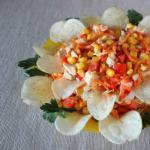Variety of fish. Diversity of fish and their taxonomy. External structure of fish
>>Variety of fish. Class cartilaginous fish
§ 42 Variety of fish. Class cartilaginous fish
Adaptations to living conditions.
Lesson content lesson notes supporting frame lesson presentation acceleration methods interactive technologies Practice tasks and exercises self-test workshops, trainings, cases, quests homework discussion questions rhetorical questions from students Illustrations audio, video clips and multimedia photographs, pictures, graphics, tables, diagrams, humor, anecdotes, jokes, comics, parables, sayings, crosswords, quotes Add-ons abstracts articles tricks for the curious cribs textbooks basic and additional dictionary of terms other Improving textbooks and lessonscorrecting errors in the textbook updating a fragment in a textbook, elements of innovation in the lesson, replacing outdated knowledge with new ones Only for teachers perfect lessons calendar plan for the year; methodological recommendations; discussion programs Integrated Lessons>>Variety of fish. Class bony fish. General Traits of Fishes
§ 43. Variety of fish. Class bony fish. General Traits of Fishes
Class bony fish
Bony fish are freshwater and marine and have a partially ossified or bony skeleton. The gill slits are covered with a cover. Usually available swim bladder, but in some it does not develop. Most fish (more than 19,000 species) belong to the class of bony fish. 82 Let's get acquainted with some orders of bony fish.
Order Sturgeon.
In sturgeons (!), most of the skeleton is cartilaginous, with bones only in the head. They can be distinguished immediately by the peculiar appearance and arrangement of the scales: thick, diamond-shaped scales run along the body in five rows - one on the back, two on the sides and two on the abdomen. The front part of the head is elongated into a more or less long protrusion - rbstrum. With this rostrum they dig at the bottom in search of food, obtaining various invertebrates hidden there.
Most sturgeon are anadromous fish.
Thus, the sturgeon, reaching a mass of 30 kg, lives in the Black and Caspian Seas, and goes to spawn in the rivers flowing into them. The beluga, the largest of the sturgeons, weighs up to 1,000 kg, does the same. A freshwater species of sturgeon - sterlet, weighing 3-6 kg, lives in various rivers of our country in its European part and in Western Siberia. All sturgeon have excellent quality meat and very valuable black caviar.
Order Cypriniformes- mostly freshwater fish 82 . These include carp, crucian carp, roach, bream and many other commercial fish. Cypriniformes feed on plant matter and various invertebrate animals. They have no teeth on the jaws (or they are poorly developed), but in the depths of the pharynx there are pharyngeal teeth, which are used for grinding food.
Order Herring.
The main representatives of this order are herrings. Most of them live in the sea and live in large flocks, traveling in search of food and for spawning. Herring feed on small crustaceans living in the water column and are of great commercial importance.
Order Codfish.
Most cod are marine fish. Their distinctive feature is the presence of a mustache on the chin.

They stay near the bottom, but do not lie on it, but constantly move in search of food. They feed on bottom invertebrates and smaller fish. They live in cold seas. In the northern seas of the USSR there are such fish as cod (weighing up to several kilograms, and some individuals - more than 20 kg) and smaller ones - haddock, herring, navaga. The only freshwater representative of cod, distributed in fresh waters almost throughout the country, is the burbot weighing 3-5 kg, some individuals - up to 20 kg. Burbot, although it lives in the middle zone in relatively warm waters, has retained the habits of its cold-water relatives. So, in the summer, when all our other freshwater fish are most active, burbot, on the contrary, climbs somewhere deeper, into holes, under snags, where it is colder, and here spends the whole summer motionless. It comes to life only in late autumn, and spawns in December or January.
All cod are day game fish 82 . Of particular value is their liver, from which medical fish oil containing vitamin B is extracted.
Order Cyst-finned.
Currently, there is only one representative of this order - coelacanth (!). This is a large fish up to 1.5 m long, found in the Indian Ocean off the coast of Africa. All other lobe-finned fish that lived both in the sea and in fresh waters died out 70-100 million years ago. The structure of the skeleton and muscles of the paired fins of lobe-finned fish is very similar to the structure of the limbs of terrestrial vertebrates. However, this will be discussed further later. 92 .
Lesson content lesson notes supporting frame lesson presentation acceleration methods interactive technologies Practice tasks and exercises self-test workshops, trainings, cases, quests homework discussion questions rhetorical questions from students Illustrations audio, video clips and multimedia photographs, pictures, graphics, tables, diagrams, humor, anecdotes, jokes, comics, parables, sayings, crosswords, quotes Add-ons abstracts articles tricks for the curious cribs textbooks basic and additional dictionary of terms other Improving textbooks and lessonscorrecting errors in the textbook updating a fragment in a textbook, elements of innovation in the lesson, replacing outdated knowledge with new ones Only for teachers perfect lessons calendar plan for the year; methodological recommendations; discussion programs Integrated LessonsOverview of the class Cartilaginous fish
These more primitive fishes than bony fish include sharks, rays and original chimeras. Most cartilaginous fish inhabit seas and oceans, and only a few live in fresh water bodies. Along with very ancient organizational features, modern cartilaginous fish have a highly developed nervous system, sensory organs and a very advanced reproductive biology.
All cartilaginous fish are characterized by the following primitive features: the skin is either covered with placoid scales or bare (in chimeras and some stingrays). The gill slits open outward, like lampreys, and there is no operculum. However, chimeras have skin membranes that cover the gill slits. The skeleton has no bones and is formed exclusively by cartilage. The unpaired fins and the distal part of the paired fins are supported by elastin (“horny”, not bony) rays. The interbranchial septa are wide, usually reaching the surface of the body. There is no swim bladder or lungs.
The characteristic features also include the following progressive features of organization, which are not found in bony fish: the brain has highly developed (for fish) forebrain hemispheres. Males have peculiar copulatory organs, representing modified parts of the ventral fins. Insemination is internal, females either lay large eggs covered with a dense horn-like membrane, or give birth to live young, the development of which occurs in the oviducts (ovoviviparity).
Modern cartilaginous fishes are divided into two subclasses: sharks and chimaeras.
subclass SHARK, or elasmobranch
This subclass includes sharks And stingrays, in which the head ends with a snout, or in other words, a rostrum, the vertebral bodies are well developed, a cloaca is present and there is no general leathery fold covering the gill slits, so that the slits open directly outward: in sharks on the sides behind the eyes, in rays - on the ventral side of the body .
Sharks and rays are widespread throughout all seas and serve as commercial targets. The meat of some sharks has a high taste and is highly valued. Shark skin is used to make handbags, shoes, etc., and is also used for linting felt. Fat containing large amounts of vitamins is melted from the liver.
Shark Squad. Sharks are the most primitive of all modern fish. In most cases, they are predators and have an elongated, spindle-shaped body with proportionally developed fins. The body is adapted for fast swimming in surface layers of water in pursuit of fish, which constitute the main food of most sharks. Numerous sharp teeth serve to capture and hold prey. Size varies greatly: some sharks have a body length of less than 1 m , others reach 5 m in length or more.
Most sharks have a similar body shape to spiny shark, or katran. Katran is the most common representative among sharks, often found in the temperate waters of the Pacific and Atlantic oceans, in the Black Sea. Body sizes up to 1 m. Species that deviate in body shape include extremely primitive frilled shark, hammerhead fish And angelfish. The frilled shark has an elongated body, 6 pairs of gill slits and a mouth located at the end of the snout, and is found in the Atlantic and Pacific oceans, where it lives at great depths. The hammerhead fish has the body shape of a typical shark, but the eyes are located at the ends of wide appendages, making the entire head look like a hammer; lives in tropical seas. The angelfish has a flattened body, wide pectoral and ventral fins; the body shape is to a certain extent transitional to stingrays.
Squad Stingray. Stingrays, which have a body flattened in the dorsal-ventral direction, are cartilaginous fish that have adapted to a bottom lifestyle. The sides of the stingrays' body are formed by highly overgrown pectoral fins, fused with the sides of the head and body; The gill slits, mouth and nostrils open on the underside of the body, while on the upper side there are eyes and large squirt tubes through which water is drawn in and expelled from the gill cavities.
Stingrays lead a sedentary lifestyle, spend most of their time lying on the bottom, and feed mainly on mollusks, the shells of which are crushed with their more or less dull teeth.
Typical stingrays, e.g. spiny stingray, radiant stingray, have a rhombic body and a long thin tail. Electric ramps They have a rounded body and live in tropical seas. Evading forms include sawfish, which in body shape is close to sharks, but has a very long rostrum, armed with large teeth, reaches several meters in length and is found mainly in tropical seas.
subclass CHIMERAS, or Whole-headed
Chimeras, which have an elongated fusiform body, differ from sharks by the presence of a leathery fold covering the gill slits, the absence of a cloaca, since there are independent urogenital and anal openings, extremely unique teeth shaped like thick plates, and a well-developed notochord, which is only surrounded by ring-shaped bodies vertebrae In males, in front of the ventral fins, there is a peculiar paired organ of unknown purpose, which is placed in a special sac, from where it can extend. Insemination is internal and the female lays eggs, which are enclosed in a very thick horn-like capsule.
Chimeras are a unique modified branch of cartilaginous fish. However, along with highly specialized characters (lamellar teeth, absence of scales, separate urogenital and anal openings), chimeras retained a number of primitive features lost by modern sharks, such as: a well-developed notochord, rudimentary vertebral bodies and a protocercal caudal fin characteristic of young individuals (adult chimeras have a heterocercal tail).
A few species of chimeras are exclusively marine, predominantly deep-sea. They have no commercial significance. A typical representative is European chimera- reaches 1 m in length. It is found off the coast of Western Europe, and is occasionally found in our waters off the coast of Murmansk.
Overview of the Bony Fish class
The class unites a huge variety of fish that have settled throughout the globe, and is the richest and most diverse class of vertebrates in terms of species composition. The most characteristic features of this class are as follows.
All bony fish have a bony operculum covering the gill slits, thus forming a more advanced gill respiration apparatus. The skeleton always contains a certain number of false bones, and the secondary jaws are also made from skin ossifications. The internal skeleton is at least partially bony. The scales (can be secondarily reduced) are ganoid or bony (but not placoid). The fins are supported by bony rays (except in lungfish). The gill septa are either small or, as is more often observed, completely absent, so that the gill filaments sit directly on the gill arches. There is either a swim bladder (which may be secondarily underdeveloped) or (in rare cases) a lung. Males have no paired copulatory organs, insemination (with very rare exceptions) is external, and the eggs are small.
Modern bony fishes are divided into 2 subclasses: Lobe-finned and Ray-finned. The lobe-finned subclass is divided into superorders lungfish And lobe-finned fish. The subclass Ray-finned contains 2 superorders: cartilaginous fish And bony fish.
subclass ray-finned
This subclass unites most modern fish. The body shape is extremely varied, but there is almost never a rostrum, and the tail is always homocercal (in some cases the caudal lobes may be reduced). The scales are bony (with the exception of armored pike). Usually it has the form of thin round plates arranged in a tile-like manner, but sometimes it is replaced by bone scutes or reduced. The skeleton is bony, and cartilage is preserved only in places between the bones that replace it. The skeleton of the pectoral fins is simplified: the radials of the fins are attached directly to the girdle of the limbs. The pelvic girdle is reduced to a pair of bony plates, and the skeleton of the ventral fins themselves is reduced to single fin rays. The brain has a structure typical of fish: the forebrain has only an epithelial roof, devoid of nerve substance, the cerebellum and midbrain are relatively large, in particular, the optic lobes are especially large. There is no cloaca. The interbranchial septa are rudimentary. The swim bladder is usually well developed, and if it communicates with the esophagus by a canal, the canal opens into the esophagus from above. The genitourinary system is similar to that of bony fish.
“A fish is an animal” - Make up the names of the fish. Pipefish. Complete the proverbs. Classification of fish. Name the fish. Large aquarium. Proverbs about fish. Variety of fish appearance. Number of species. Complete the sentences and answer the questions. General characteristics of the fish class. Find the error in the picture. Classes of fish. Spiny shark.
“Commercial fish” - Orders of commercial fish. Carp-like. Salmonidae. Order Sturgeon. Order Cypriniformes. Variety of commercial fish. Order Codlike. Codfish. Order Salmonidae. Sturgeon. Herring-shaped. Order Herring-like.
“Biology 7th grade “Pisces”” - Clown fish. Where does the Sturgeon River flow? Fish - Ruff. Three minnows. Crossword. Cardinal. The jumper is muddy. Coelacanth. Som. Amur. Burbot. Variety of fish. Literary competition. Fish - needle. Sardine. Saw fish. A large predatory fish with a flat body and a sharp tail. Neon. Sturgeon. Napoleon. Fish telescope. Gurnard.
“Internal structure of fish” - 1. Name the organs and organ systems of fish. Circulatory system. Intermediate. Expanding. Oblong. Venous blood, arteries. Fins. Spine + ribs. Spinal cord. Venous blood, veins. Shrinks. Gill covers. Gill arches. Gas exchange. Pancreas. What features of the internal structure help fish live in water.
“Reproduction and development of fish” - How can this phenomenon be explained? Analyze the information. Write a logically connected story using terms (work in pairs). The fertilized egg begins to divide and a multicellular embryo is formed. Fish larvae. Lesson objectives. The freshwater fish bitterling lives in rivers where bivalves live.
“The Variety of Fishes” - Fish is a clown. Fish is a butterfly. Torso. Fish is a hammer. Som Soldatova. Horse. Head. Fish is a skate. Herbivores. Omnivores. Guppy. Marine. Cockerel. Som. Parents and children have all their clothes made of coins. Birds. Growing. 4 paws, wool is fed with milk and they breathe through the lungs. Flounder. They are developing. They eat. Questions:
There are 18 presentations in total
- Row Sturgeon
- Row Perciformes
- Row Carp-shaped
- Row Herring
- Row Catfish
- Series Salmonidae
- Row lobefins
- Row Lungbreathes
The Pisces superclass is divided into 2 classes:
- class Cartilaginous fish
- class Bony fish
The latter combines 4 subclasses:
- Semicartilaginous,
- Ray-finned,
- Dipnoi,
- Locofin.
Row Sturgeon
Representatives:
- beluga,
- sturgeon,
- stellate sturgeon,
- sterlet,
- Bister is a hybrid of beluga and sterlet.
The front part of the head is elongated and turned into a snout. The mouth in the form of a transverse slit is located on the ventral side. The tail is unevenly lobed (heterocercal type). The pelvic fins are located at a considerable distance from the pectoral fins. The scales (ganoid) are large, located in a row of ami (bugs), and small bony plates formed by bony scutes are scattered between them. A chord passes through the spine. The skeleton mainly consists of cartilage, but there are also bone elements.
They feed mainly on bottom invertebrates.
Migratory fish. To hatch eggs, they move upstream in rivers.
Sterlet and shovelnose live in rivers and lakes. They have mainly adapted to a bottom-dwelling lifestyle.
Row Perciformes
Representatives:
- river perch,
- zander,
- horse mackerel,
- mackerel,
- tuna,
- bulls,
- sword - fish.
A large group of bony fish. Body shapes and sizes vary. Length from 1 cm to 5 m, weight up to 900 kg. Scales of ctenoid type. The swim bladder is not connected to the esophagus (closed bladder). The fins, especially the dorsal ones, have sharp, spiny rays. They live in fresh and salt waters.
The female common pike perch spawns eggs on the root parts of plants; the male guards the clutch.
Fish have a variety of protective colors. It camouflages the fish and helps to watch for prey.
Example 1
The dark green color of the back makes the perch invisible from above against the dark background of the bottom, the side stripes camouflage the animal among aquatic vegetation; The yellowish-white color of the abdomen merges with the light background of the surface layers of water and makes the perch invisible to predators swimming in the lower layers of water.
Note 2
Some coastal fish (gobies) have suckers formed as a result of the fusion of the ventral fins. Therefore, these fish are kept at the bottom during the ebb and flow of the tides. The body color of gobies resembles the color of the soil.
Industrial fish. Common mackerel is common in the Black Sea. Common and Black Sea mackerel are found in the Black and Azov Seas.
Row Carp-shaped
Representatives:
- carp,
- crucian carp,
- roach,
- tench,
- White amur,
- silver carp,
- ram,
- vobla
- and etc.
They live mainly in fresh water bodies, where spawning occurs. The rays in the fins are soft. The mouth is toothless, but there are pharyngeal teeth located on the last gill arch and are well developed. They are used by fish to grind food. Many have antennae near their mouths - organs of touch. The swim bladder is connected to the esophagus (open vesical). They feed on plant foods and various invertebrate animals. The anterior vertebrae have changed into bones that connect the swim bladder to the inner ear, thereby enhancing hearing.
Carp-like fish generally stay in small schools. These are roach, bream, crucian carp, etc. During the spawning period and for wintering they gather in large schools.
Cypriniformes are an important fishery object. The following species are raised in pond farms: carp, silver carp, carp, and trout.
Note 3
Carp, which is a domesticated form of carp, is bred in warm-water pond farms. Carp has tasty and fatty meat. They grow quickly. Using a special method of growing and feeding carp, developed by Professor V.A. Movchan, they reach 700 - 800 g or more in one year.
Row Herring
Representatives:
- Atlantic,
- Pacific,
- black sea herring,
- anchovy,
- sprat,
- sprat.
Marine, mostly small, fish. The body is flattened laterally. The lateral line is poorly developed or absent at all. The head is not covered with scales. The rays in the fins are soft. Silver color. For spawning, it approaches the shores in large flocks. The swim bladder is connected to the intestines. The jaws contain teeth. Surface water filters.
Herring, living in the water column, stay in large schools throughout the year. This lifestyle has many benefits. Firstly, it is easier to avoid danger in a flock. A predator can approach one fish unnoticed. And when a hundred eyes are watching him, it’s harder to get closer. If one fish notices an enemy, it quickly rushes to the side. Her unusual behavior alarms the entire flock. Having noticed the enemy, the fish either hide or blur. Secondly, most fish use less oxygen for respiration during wintering together than when wintering alone. In addition, herrings have a characteristic color, as well as a bluish tint, and therefore are hardly noticeable in the water.
In the basins of the Black and Azov Seas, Black Sea herring, Kerch herring, Black Sea sprat, and anchovy are common.
Row Catfish
Fishes of this series have no scales. Their mouth is armed with teeth. They usually have very long mustaches. Catfish are predominantly freshwater fish. By type of food - scavengers, predators. A typical representative is the common catfish. It reaches 5 m in length and weighs up to 400 kg.
The industrial importance of catfish is relatively small. Most species of catfish live in countries with tropical climates.
Series Salmonidae
Representatives:
- salmon,
- pink salmon,
- chum salmon,
- salmon,
- trout.
The body length of the fish reaches 150 cm, and the weight reaches 60 kg. The lateral line is complete. There is an adipose fin. Migratory fish. During the breeding season, the body of some salmon acquires a bright, mating color. They feed on insects, crustaceans, fish, and frogs.
Distributed in water bodies of North Asia, North-West Africa, North America. Salmon and trout are common in Europe. The most commercially important Pacific salmon are pink salmon, chum salmon, sockeye salmon, Chinook salmon, etc.
Row lobefins
Endangered fish. The only species left is the coelacanth.
The paired fins are adapted not only for swimming, but also serve as support on the bottom (hard substrate). The bones of the paired fins of lobe-finned fish are to some extent similar to the bones of the five-fingered limb of vertebrates: humerus, ulna and radius; a number of rays at the end of these fins correspond to the bones of the hand. The body is thick, covered with massive scales. There is a cesspool. Size - from 1 to 1.8 m, weight - from 19.5 to 95 kg.
For a long time it was believed that these fish were extinct. But in 1938, one representative of cross-finned fish was found. Now several dozen individuals of coelacanth have already been restored. They have adapted to life in the waters of the Indian Ocean off the coast of Africa.
They are the object of research as a living fossil.
Row Lungbreathes
Of the lungfishes, 6 modern species are known, living in fresh water bodies of Australia (horntooth), equatorial Africa (4 species of protoptera) and South America (neoceratodes), which dry up in the summer. These fish have adapted to use air oxygen with the help of lungs (the horned tooth has one, the rest have two), which connect to the esophagus and have a cellular structure.






